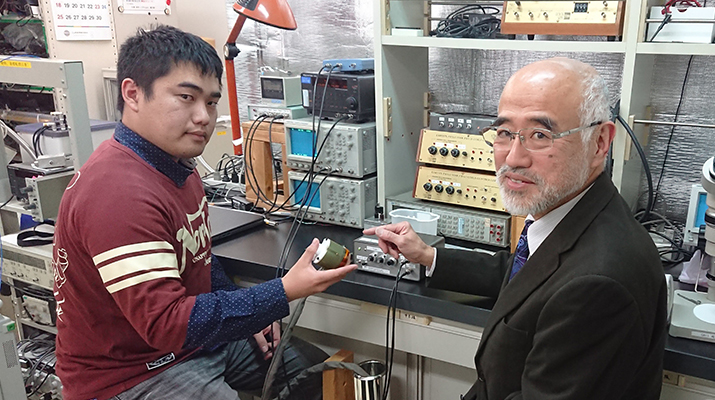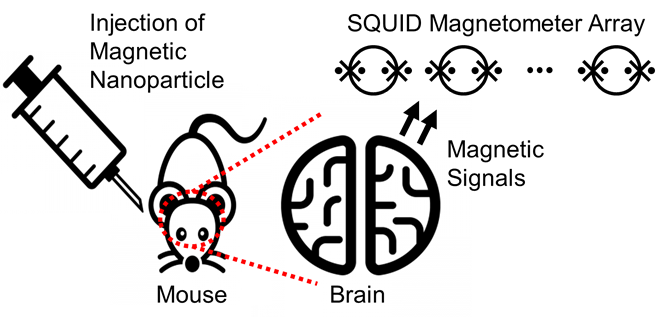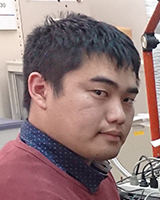
ここからコンテンツです。

Chasing small magnetic fields
One application of SQUIDs, superconducting magnetic sensorsThe High-Temperature Superconductors in High Frequency Field (HTSHFF) 2018 Yamagata, Best Student Poster Award
By Moriki Kabasawa
The Applied Sensing Technology Laboratory at the Department of Environmental and Life Sciences in Toyohashi University of Technology is working on the research and development of a non-invasive device for measuring brain functions by using SQUIDs (Superconducting Quantum Interference Devices), or superconducting magnetic sensors. Superconducting magnetic sensors are known to have the highest sensitivity among magnetic sensors. By releasing small magnetic markers in the bloodstream and detecting these magnetic markers in the brain with SQUIDs, blood flow in the brain can be studied in a non-invasive manner. In addition, it is possible to measure the direction and speed of blood flow in detail by using multichannel SQUIDs.
The results of this research was presented at HTSHFF 2018 Yamagata in June 2018 and received the Best Student Poster Award. This award is given to the student who gives the best poster presentation in English as a young researcher in the field of high temperature superconductor research.
Motivation for this research, struggles in research, and impressions after receiving the award
The Applied Sensing Technology Laboratory that I belong to is working on the production, assessment, and measurement of superconducting magnetic sensors called SQUIDs (Superconducting Quantum Interference Devices). The multi-channel SQUID that we are currently using is designed with three channels in one element. The production of these elements involves many processes, and it takes about one week to make a single element.
I had a hard time making enough elements for use in measurement. Since my research can only begin after making these elements, I had to overcome various difficulties in assembling the device, improving it, and finding a suitable measurement method. I could not have made progress in my research nor received this award without the advice of Professor Saburo Tanaka, as well as the help from other members in the laboratory. I am very grateful to Professor Tanaka and to my laboratory members who all supported me throughout my research.
Details of the research
Various methods have been used in research to measure brain functions in a non-invasive manner, including magnetoencephalography and electroenceohalography. Depending on the purpose of measurement, methods were either selected individually or combined together in order to measure brain functions. The focus of our research is on a non-invasive method of measuring blood flow in the brain by injecting extremely small magnetic markers called magnetic nanoparticles into the blood that flows to the brain, and performing measurements with SQUIDs, highly sensitive superconductive magnetic sensors. Rodent models, as a step prior to application on humans, are used as subjects, and we can expect the research to further advance the field of brain research.
The SQUIDs that I produced can measure a magnetic field at 1/105 of the magnetic flux quantum Φ0 (2.07×10-15 Wb). The extremely small magnetic signals from a small number of magnetic nanoparticles moving in a magnetic field can be detected with SQUIDs. In order to study the direction and speed of blood flow by performing measurements on magnetic nanoparticles inside blood, there was the need to create a multichannel system using multiple SQUIDs so as to understand the relationships between magnetic signals obtained from different channels. To solve this problem, measurements were performed repeatedly with a variety of different movement paths in samples and different directions for the applied magnetic field. Through these measurements, I was able to find the signal waveforms derived from relationships between the position of the SQUIDs, the movement path of the magnetic nanoparticles, and the direction of the applied magnetic field.

Prospects
In our current measurements, experiments are being conducted using samples that are modeled on the flow of blood in the brain, and signal waveforms are studied under known measurement conditions. In the future, we hope to enable conclusions to be made in unknown measurement conditions on the basis of previously measured waveforms. We will proceed with measurements using mice and other small animals, with the ultimate aim of establishing a non-invasive method for studying the brain.
小さな磁場を追う
超伝導磁気センサSQUIDの応用としてThe High-Temperature Superconductors in High Frequency Field (HTSHFF) 2018 Yamagata, Best Student Poster Award
By 樺澤 守力
豊橋技術科学大学環境・生命工学系、バイオセンシング応用研究室は、超伝導磁気センサSQUIDを用いて、脳の働きを非侵襲で測定する装置の研究・開発を行っています。超伝導磁気センサは最も高感度な磁気センサとして知られています。血流に小さな磁気マーカーを流し、SQUIDで脳の血管を流れる磁気マーカーを検出することで脳を流れる血流を非侵襲で調べることが可能となります。加えて、測定に利用するSQUIDをマルチチャンネルにすることで血流の詳しい方向や速度の測定が可能となります。
本研究の成果を2018年6月、HTSHFF 2018 Yamagataにおいて発表し、Best Student Poster Awardを受賞しました。これは、将来の高温超伝導研究分野を担う若手の研究者である学生によって英語で行われるポスター発表の中から、最優秀と認められる研究成果発表を行った者1人に対して贈られる賞です。
本研究に取り組んだきっかけ、研究の苦労話、受賞時のエピソード等
私が在籍しているバイオセンシング応用研究室では超伝導磁気センサSQUID (Superconducting QUantum Interference Device)の作製や評価、測定を行っています。現在使用しているマルチチャンネルSQUIDは1つの素子に3チャンネルあるデザインとなっています。素子の作製にはいくつもの工程があり、1つの素子を作製するのに1週間程度必要となります。測定において十分な素子を作製するのに苦労しました。また、素子が完成してからが研究のスタートでもあるため、装置の組み上げや改良、測定方法で様々な困難がありました。しかし、本応用研究室の田中三郎教授のアドバイスや、研究室の仲間たちの助けもあり研究を進めることができました。このアドバイスがなければ賞を受賞することはできませんでした。私を支え、助けてくれた田中三郎教授や仲間に感謝しています。
研究内容の詳細
脳の働きを非侵襲で調べる方法として脳磁図や脳波計など様々な方法が研究に利用されています。これらは測定する用途によって適切に測定方法を選択または組み合わせて利用されています。我々は脳を流れる血流に磁性ナノ粒子と呼ばれる非常に小さい磁気マーカーを入れ、高感度な超伝導磁気センサSQUIDで測定することで、脳を流れる血流を非侵襲で測定する方法を研究しています。また、測定対象をヒトではなく研究の前段階で利用されるげっ歯類としており、脳の研究のさらなる発展が期待されています。
私が作製したSQUIDは単位磁束量子Φ0 (2.07×10-15 Wb)の1/105磁場を測定することができます。磁場中を移動する少量の磁性ナノ粒子からの非常に小さな磁気信号を、SQUIDを利用することで検出することが可能となります。血中を流れる磁性ナノ粒子を測定し流れる方向や速度を調べるためには複数のSQUIDからなるマルチチャンネルを使用し、各チャンネルで得られる信号の関係を知る必要がありました。この問題を解決するために、様々なサンプルの移動経路や磁場の印加方向などを変更した測定を繰り返すことで、SQUIDの位置、磁性ナノ粒子の移動経路、磁場の印加方向の関係から得られる信号波形を知ることができました。
今後の展望
現在の測定では脳を流れる血流を模したサンプルを使用し実験を行っており、既知の測定条件のときの信号波形を調べています。今後は測定によって得られる波形から未知の測定条件を決定可能にしていきたいと考えています。最終的には、マウスなどの小動物を用いた測定を進めていき、脳を非侵襲で調べる新たな方法を確立していきたいと考えています。
Student Profile

| Name | Moriki Kabasawa |
|---|---|
| Affiliation | Department of Environmental and Life Sciences |
| Title | Master course student (2nd grade) |
| Fields of Research | Superconducting Electonics / Bio Sensing Application / Sensor Technology/ Contaminant detection/ Nondestructive Evaluation |
ここでコンテンツ終わりです。
